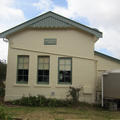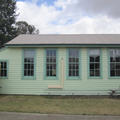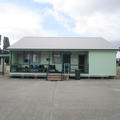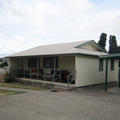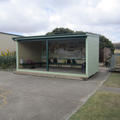< Early Canberra Government Schools
Tarago Public School [1878 - 2016]
Previous Name/s: Sherwin's Flats / Upper Tarago
In 1978 A School Centenary Committee published 'Tarago Public School Centenary 1878 - 1978'. The following is an extract from that publication.
What is in a name?!
In 1877 the present township of Tarago was known as Sherwin Flats, and Lake Bathurst township, some four miles to the north, where a school had opened in 1868, was known as Tarago. The name 'Tarago' was transferred from onto the other in 1884, when that section of the Cooma railway line was completed. Both Lake Bathurst and Tarago railway stations were opened on January 3 1884. The Post offices also changed names in that month, but the Department of Education did not follow suit until 4 August 1884.
In late 1877, at the initiative of John Carney, the people of Sherwin Flats established a private school, with John Jacob as teacher. Jacob had been teaching in the NSW southern districts since 1858, but had been dismissed by the Council of Education from the New Line School in September 1877 'on account of his intoxication'. It was Jacob who made the first move to have Sherwin's Flats recognised as a government school, writing to the Council on 25 January 1878:
"The patrons of this school are desirous to place it under the Councils Regulations. I have taken the Pledge to refrain for life time from all intoxicating Drinks. May I hope to be appointed as Teacher, under the Council of Education, to this, or any other school - Praying not to be cast to utter ruin but to give me one more chance to regain a standing".
Despite his alcoholic tendencies, Jacob was an experienced teacher, and the people of Sherwin's Flats were lucky to have found him.
In February the parents also wrote to the Council about the possibility of establishing a Provisional school. Receiving in reply a copy of the official application form they returned it with all necessary information on12 February. It was signed be members of a local committee, who would be responsible for overseeing the school's operation. There were six of them:
John Carney - farmer; catholic
John Kelleher - farmer; catholic
John Calaghan - farmer; catholic
George Cuzner - farmer; catholic
Stephen Browne - blacksmith; catholic
Edwin Spice - inn-keeper; anglican
An attendance of thirty-three children from thirteen families was promised. They were:
John Carney - 5
John Kelleher - 3
George Cuzner - 1
Stephen Browne - 5
Edwin Spice - 1
Patrick Tynan - 5
Lawrence Purcell - 4
John Wilson - 3
John Seehane - 2
Thomas Peters - 1
Matthew Lynch - 1
Patrick Cody - 1
Patrick Sheedy - 1
The pre-existing school, which had about 18 pupils, was conducted in a slab building belonging to John Carney, on the Goulburn-Braidwood road just north of the site the school was to occupy from the 1880's on.
First school building
Inspector McIntyre visited Sherwin's Flats in March (1878) and found the 20' by 14' schoolroom suitable, and prospects good for an average attendance of about sixteen. Since the nearest school was four miles away and the settlers were generally poor farmers, many of them unable to read or write, he thought that the Council should grant aid. He also recommended that Jacob be appointed on probation, since he had "promised to abstain from intoxicating drink and has been strongly recommended by the school committee". Aid was granted on 18th March and the new Provisional school - known as Sherwin's Flats - began operating at the end of the month.
The school got off to a good start, with average attendance of 22 from an enrolment of 25. Jacob proved to be a satisfactory teacher, and his wife taught sowing and supervised the girls. Teaching focussed on reading, writing and arithmetic - a rather mechanical education, with heavy emphasis on memorising information which was of little meaning or relevance to the children of poor farmers. In 1880 an increase in enrolments meant the granting of Public School status.
Agitation for a new school
In April 1882 parents met and unanimously resolved to request the Department to erect a proper school house to replace the small one rented from Carney. Inspector Dwyer thought the existing building adequate, but conceded that the arrival of the Cooma railway line would bring an increase in population. As it was difficult to estimate the size or permanency of the expected population, he recommended that the Department acquire a site then wait to see what size school building would be required.
A two acre block immediately south of the temporary school was chosen and acquired from Carney in September 1883.In fact Carney has no clear title to the land, having occupied in around 1860 after a gold mining company had abandoned it. Legal complications dragged on until at least 1887 when the Department paid Carney compensation of ₤60 plus interest to the court, and left the disputants to fight out their own battle. Meanwhile the five year lease on Carney's building at a nominal shilling a year expired in April 1883 and was renewed at ₤26 a year, provided that Carney repaired the building.
Dwyer recommended in June the erection of a new brick building to accommodate 35 pupils, together with a teachers residence. At the time the enrolment was 46, and it was to reach 82 by the end of the year owing to an influx of railway workers. The average attendance of the itinerant worker's children was very low however.
1883 was a year of enormous strain for the Department, resulting from a growing population, the introduction of a degree of compulsory attendance with the education Act of 1880, and the withdrawal of state aid to church schools at the end of 1882. These changes necessitated a hasty school building program. Sherwin's Flat therefore got a (relatively) cheap building - the Department's first model of a temporary classroom. It was a wooden structure with a curved iron roof; identical building were springing up all over the colony in the 1880's.
Meanwhile the Goulburn 'Southern Argus' was very critical of the 'Upper Tarago' school - as Sherwin's Flat was also known:
"Continuing along the main Braidwood road and passing several places calling for no special remark, the traveller notices what is known as a public school at Upper Tarago. This is conducted in a slab hut roofed with bark. On enquiring we learned that forty children attend this school, and the number would be increased considerably if suitable premises were provided. The present building is simply a disgrace to the Department. Miss Naughton, the lady in charge, is highly spoken of by the parents of children in attendance, but very little encouragement is offered for a proper system of tuition in such a dilapidated place'.
Plans for a new building were ready by August 1883, and the tender of William Thomas for ₤186 was accepted in October. The building was to measure 22' x 16'. At the standard then in use of eight square feet per child this provided for 44 pupils. Carney complained on behalf of the parents that this was inadequate - to no avail. Unfortunately for Sherwin's Flat, the builder Thomas was an insolvent using a false name, and was very slow in building the new school. Eventually it had to be completed by another contractor at Thomas' cost. It was occupied but not quite finished in July 1884.
New teacher - Jethro Clark
In the meantime Eliza Naughton had resigned, and Jethro Clark had begun his fourteen years as teacher. His two predecessors had obtained board and lodging with Carney, but Clark paid ₤1 a week to board at the hotel owned by George Miller - the Department contributing 7/6 d a week rent allowance. Clark was unhappy with this arrangement however and in November 1885 asked the Department to erect a cheap timber vested residence:
"As the above school is likely to maintain its present position as regards the attendance, and as I am very well satisfied to remain here because of the nearness of the railway, and the convenience thereby attained, I have thought of marrying and settling here until such time as I can so improve myself as to enable me to become eligible for appointment to a better school.
Upon making enquiry however, I find that in Tarago there is not a suitable vacant house that would serve me as a residence, nor do I know of anyone possessing land here who would care about putting up a house for me, neither am I in a position to buy land and erect a house for myself".
His arguments were accepted, and plane prepared for a residence of four rooms and a kitchen. The tender of ₤292 from local builder James Sturgis was accepted in April 1886. Clark was able to occupy the residence in January 1887 - excellent timing since he got married in December 1886, and thenceforth had his wife to help him in the school.
Religious differences
Clark seems to have faced only one other problem at the school, that of the Catholic parents reaction to the general religious teaching, including scripture readings, which was part of the course of 'secular instruction' laid down by the 1880 Act. In 1884 a number of Catholic parents had objected to their children reading or being within hearing of the scripture lessons. Was the school only had one room, and 44 of the 72 pupils were Catholics, Clark placed his problem before District Inspector Dwyer. On Dwyer's advice, he omitted the readings, but endeavoured to teach the children 'the great facts of scripture history' and to give careful attention to the children's 'moral education'. In 1890 however, Inspector Cooper objected to Clark committing part of the required course of instruction. By this time there were 20 Catholics and 26 Protestants. Clark obtained letters from five Catholic parents objecting to third children taking part in scripture readings, including one from John Carney, which read:
"......for my part I don't see any harm in reading them but a soldier must obey his superior offices, the Catholic Church objects therefore I must".
The Department decided that the best course of action would be for Clark to place the non-participating pupils at the far end of the school room and set them other work. Clark was given instructions to that effect.
Enlargement of the grounds
In the early 1890's the Department was taking steps to enlarge small school sites. In December 1890 Inspector Cooper recommended that Tarago, as it was now called, should gain an extra two acres to the south of its site. The land was resumed from Robert Cooper in November 1891, but since like Carney, he had difficulty establishing his title to the land, he did not receive his compensation of ₤50 until the end of 1895. The extra land was fenced in 1892 so that it could be used both as a playground and as a horse paddock for those children who rode to school.
New brick building
In February 1892 Inspector Cooper also recommended the erection of a new brick building. The enrolment was actually lower that when the school was planned in 1883, but the Department's accommodation standards were now more generous. At ten square feet per child the building accommodated only 35, and Cooper described it as 'hot and very uncomfortable when crowded with the usual attendance'. HE continued:
"The population of Tarago is permanent, and is steadily increasing. The present school was intended as a temporary structure. It could not, I'm my opinion, be safely enlarged, exposed as it is to fierce westerly winds which often try the stability of the best built houses. Moreover, even if enlarged, it would, owing to the original design, be difficult to make it comfortable"
It was decided to erect a brick building containing a school room 25' x 19', situated very close to the old school and connected to it by a boarded In passage so the old building could conveniently serve as an extra classroom. The tended from Messrs Franklin and Finlay of Goulburn for ₤284 was accepted in April, and the new building was occupied on 15th September 1892.
While Clark had difficulty passing the examinations for his Second Class Certificate - he failed four times from 1884 to 1895, before his eventual success in 1896-7 - he was at his best in improving the school grounds and instructing the pupils in agriculture. In the late nineteenth century the Department paid considerable attention to school sites and the use to which they were put, agriculture being introduced into the curriculum in the 1880's, and Arbor Day inaugurated in 1890.
Clark was extremely busy and effective at Tarago in fencing and establishing school gardens and agriculture plots, in obtaining trees and shrubs from the Botanical Gardens in Sydney, in keeping bees, and a range of other rural activities. In March 1892 Albert Gale, the Department's Supervisor of agriculture visited the school and found that:
"A good deal of useful and ornamental work has been done in the playground of this school. A large portion of the area....has been ploughed since the present teacher has been there, with the intention of sowing it with a mixture of grass seeds to form a lawn, but what should have been grass turned out to be English reed clover.....In front of the school is a well attended flower garden enclosed with a wire netting fence and filled with showy blooms. About 50 shade trees of various kinds have been planted (some have been in the ground for two years) and all of them are very healthy. The teacher's gardens are well kept, the whole being a picture of neatness."
The following year Clark applied for a bonus obtainable by teachers doing outstanding work in these fields, and duly received ₤2.
Like many other teachers of that period in small and poorly-educated communities, Clark was useful to Tarago citizens in a number of respects. In 18992 he gained the Department's permission to make out the accounts of the local butcher and baker for a small fee, in order to help 'and industrious and hardworking young man in gaining an honest likelihood'. In 1896 however, the newly established Public Service Board refused to allow him to continue this practice. The Board did relent however on the matter of allowing him to be Secretary of the Loyal Tarago Lodge of Oddfellows and receive ₤2 a year. Clark was popular at Tarago, and the district regretted his transfer to the higher classification school at Bundanoon at the start of 1898.
William Roberts settled in quickly at Tarago, despite a serious epidemic of scarlatina and measles in 1898. He soon found the rather small and primitive residence a problem. In 1900 he asked for an extra bedroom and a bathroom, pantry and laundry. Despite repeated requests the improvements did not come until 1903, when the 1884 school building was relocated to the rear of the residence and converted into the required rooms, and painting and repair work carried out.
First Parents and Citizens Association
The first reference to a P & C is found in 1908, when Mrs A Barrett as Secretary sought improvement to the lighting in the schoolroom, complaining that the pupils eyes were being affected. The only windows were the four in the east wall behind the children desks. An additional window was installed in each the north and south walls in 1909. Thomas McPaul (who had succeeded Roberts in 1908) was criticised in 1909 for allowing the agricultural work done so well by his two predecessors to fall into a state of neglect. the most serious complaint was that McPaul had destroyed the boys cricket pitch and pt that area of the school paddock under cultivation, selling the year's production of barley for about ₤4 and retaining the money.
Parents' petition
McPaul's successor, Alexander Cruikshank (1909-1920) was also subject to Inspectorial criticism during his years at the school, in particular for defects in his teaching and the pupils' poor results in 1911 and 1915. While he was on long service leave from April
1920 to January 1921, the parents asked that he not be sent back to Tarago, but that Michael Byrne, who had temporarily taken his place, be retained. This is what the Department intended anyway.
Tarago had for many years had 40 - 50 pupils, but numbers declined during World War 1, and by September 1919 the enrolment was only 23. By then the school and residence needed general renovations; the Inspector was convinced that the lower figures did not mean there was any risk of the school having to close. ₤184 worth of repairs were accordingly carried out at the end of 1919.
Tarago Public School Centenary 1878-1978. Centenary Committee, 1978.
Location Map
Related Photos
Teachers
- Jacob, Mr John
03/1878 - 09/1882 - Naughton, Eliza M A
09/1882 - 01/1884 - Clark, Mr Jethro
03/1884 - 12/1897 - Roberts, Mr William Henry
01/1898 - 03/1908 - McPaul, Mr Thomas
03/1908 - 11/1909 - Cruikshank, Mr Alex
11/1909 - 03/1920 - Byrne, Mr Michael
04/1920 - 03/1926 - Lewis, Mr Roy
03/1926 - 12/1931 - Whiting, Virgil
01/1932 - 12/1936 - Taylor, Mr Stanley
01/1937 - 12/1941 - Goodacre, Mr Cecil
01/1942 - 12/1948
School Website
NSW Government schools from 1848
- Tarago Public School (external link)
< Early Canberra Government Schools
If you are able to assist our work of identifying, documenting, and celebrating the early bush schools of the Canberra region, please contact us or .



